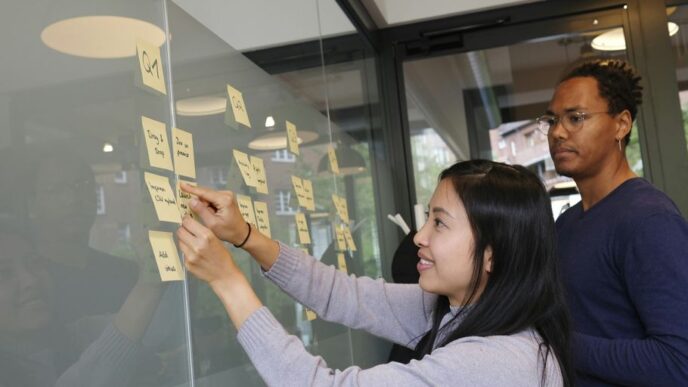Ever wonder how some leaders just seem to get it right? A lot of times, it comes down to really knowing themselves and how they come across to others. That’s where 360 degree feedback coaching steps in. It’s a way for people to get a full picture of their performance, not just from their boss, but from everyone around them. This kind of feedback can really help leaders grow and get better at what they do.
Key Takeaways
- 360 degree feedback coaching helps you see yourself through the eyes of others, giving you a more complete picture of your strengths and weaknesses.
- Getting feedback from different people like your boss, coworkers, and direct reports helps you understand your impact and how you can improve.
- This type of coaching is great for leaders because it helps them become more aware of themselves and figure out where they need to develop.
- Using 360 degree feedback coaching means setting clear goals and making specific plans to work on the areas that need it.
- Working with a coach can make a big difference in understanding your feedback and turning it into real progress.
Understanding 360 Degree Feedback Coaching
Defining Comprehensive Feedback
Okay, so what is 360 degree feedback coaching? Basically, it’s like getting the full picture, not just a snapshot. Instead of only hearing from your boss, you get input from peers, subordinates, and sometimes even clients. This creates a more well-rounded view of your performance. It’s not just about what you think you’re doing well or poorly, but what everyone thinks. It’s a performance evaluation method that aims to give you a complete understanding of your strengths and weaknesses.
The Value of Multiple Perspectives
Why bother getting feedback from so many people? Well, think about it: your manager sees one side of you, your team sees another, and your clients see yet another. Each group has a unique perspective. Getting all these viewpoints helps identify patterns and trends you might miss otherwise. For example, you might think you’re a great communicator, but your team might feel you don’t listen well. This kind of insight is super valuable. It highlights discrepancies between how you see yourself and how others perceive you. It’s about getting a more nuanced understanding of your impact.
Bridging Self-Perception and External Views
One of the biggest benefits of 360 degree feedback is that it helps bridge the gap between how you see yourself and how others see you. We all have blind spots. Maybe you think you’re delegating effectively, but your team feels micromanaged. Or perhaps you believe you’re approachable, but colleagues find you intimidating. This feedback shines a light on those areas, giving you a chance to adjust your behavior and improve your relationships. It’s about enhancing self-awareness, which is key for effective leadership. It allows you to develop a more realistic and accurate self-image, leading to better decision-making and stronger relationships.
The Importance of 360 Degree Feedback Coaching in Leadership Development
Enhancing Self-Awareness for Leaders
360 degree feedback is super useful because it helps leaders see themselves as others see them. It’s like holding up a mirror, but instead of just your reflection, you’re seeing how your actions impact those around you. This is key because many leaders have blind spots – things they don’t realize they’re doing that might be holding them back. By getting feedback from peers, subordinates, and supervisors, leaders can get a more complete picture of their strengths and weaknesses. This comprehensive feedback is the first step to becoming a better leader.
Identifying Strengths and Development Areas
One of the biggest benefits of 360 degree feedback is that it pinpoints exactly where a leader excels and where they need to improve. It’s not just about finding fault; it’s about recognizing what’s working well and building on those strengths. For example, a leader might be great at strategic planning but struggle with communication. The feedback highlights these areas, allowing the leader to focus their development efforts where they’ll have the most impact. It’s like having a personalized roadmap for growth. Here’s a quick look at some common areas identified:
- Communication Skills
- Teamwork and Collaboration
- Decision-Making
Fostering Continuous Growth and Improvement
Leadership development isn’t a one-time thing; it’s an ongoing process. 360 degree feedback helps create a culture of continuous improvement by encouraging leaders to regularly seek feedback and make adjustments. It’s about embracing a growth mindset and seeing feedback as an opportunity to learn and evolve. This means not just accepting the feedback but actively using it to set goals, develop new skills, and become more effective in their roles. It’s about leadership development and always striving to be better.
Implementing 360 Degree Feedback Coaching Effectively
Best Practices for Survey Design
Okay, so you want to get 360 feedback going? The survey is where it all starts. Make sure the questions are super clear and focused on behaviors, not personality. You don’t want people guessing what you’re asking. Think about using a mix of question types – some scales (like, "On a scale of 1 to 5…") and some open-ended questions where people can give more detailed thoughts. Also, keep it short. No one wants to spend an hour filling out a survey. A shorter, focused survey gets better responses. You want to make sure you are designing surveys that are effective.
Ensuring Anonymity and Confidentiality
This is huge. If people don’t trust that their feedback will be kept private, they won’t be honest. And if they aren’t honest, the whole thing is pointless. Make it crystal clear how the data is collected, stored, and reported. Use a third-party platform if you can; it adds another layer of trust. Remind everyone involved that feedback is only shared in aggregate form, without names attached. This helps people feel safe enough to give real, useful feedback. It’s important to maintain employee acceptance of the process.
Providing Actionable Insights
So, you’ve got all this feedback. Now what? If it’s just a bunch of vague comments, it’s not going to help anyone. The report needs to highlight specific areas for improvement and suggest concrete steps the person can take. Think about breaking down the feedback by category (like communication, teamwork, problem-solving) so it’s easier to digest. And definitely include some positive feedback too! It’s not all about fixing problems; it’s also about recognizing strengths. Make sure you have clear objectives for the feedback.
Integrating 360 Degree Feedback Coaching into Development Plans
Setting Targeted Development Goals
Okay, so you’ve got your 360 feedback. Now what? It’s time to turn that feedback into something useful. That means setting some real, targeted development goals. Don’t just say, "I want to be a better leader." Get specific. What exactly do you want to improve? Is it your communication skills? Your ability to delegate? Your strategic thinking? The clearer your goals, the easier it will be to track your progress. Think about what’s most important for your role and for the company, and then set goals that align with those priorities. For example, if feedback indicates a need to improve team collaboration, a targeted goal could be to implement a new project management system and conduct weekly team meetings to improve collaboration.
Creating Personalized Action Strategies
Once you have your goals, you need a plan to achieve them. This isn’t about generic advice; it’s about creating personalized action strategies that work for you. What steps will you take to reach your goals? Maybe it involves taking a course, finding a mentor, or practicing new skills on the job. The key is to break down your goals into smaller, manageable steps. Don’t try to change everything at once. Focus on one or two key areas, and then build from there. For example, if your goal is to improve your communication skills, you might start by practicing active listening in meetings, asking for feedback from colleagues, or taking a public speaking workshop. Make sure your strategies are realistic and achievable, and that they fit into your daily routine. Here are some ideas:
- Shadow a colleague known for their strengths in your target area.
- Dedicate 30 minutes each week to reading articles or books on the topic.
- Seek out opportunities to practice your new skills in low-stakes situations.
Regularly Reviewing Progress and Adjusting
This isn’t a "set it and forget it" kind of thing. You need to regularly review your progress and adjust your strategies as needed. Are you making progress toward your goals? What’s working? What’s not? Be honest with yourself, and don’t be afraid to change course if something isn’t working. Get feedback from others along the way, and use that feedback to refine your approach. Think of it as an ongoing experiment. You’re constantly learning and adapting as you go. It’s important to track your progress so you can see how far you’ve come. Here’s a simple way to do it:
| Goal | Action Steps | Progress | Notes |
|---|---|---|---|
| Improve delegation skills | Delegate one task per week to a team member | Ongoing | Team member A’s performance improved after receiving delegated task. |
| Enhance public speaking | Present at team meetings more frequently | In progress | Still feeling nervous, but getting better with each presentation. |
Best Practices for Leveraging 360 Degree Feedback Coaching

Cultivating a Constructive Feedback Culture
It’s important to create an environment where feedback is seen as a gift, not a weapon. This means promoting open communication and making it clear that the goal is growth, not judgment. When people feel safe sharing their thoughts, the feedback becomes much more useful. Think about setting up regular check-ins, not just formal reviews, so people get used to giving and receiving input. This helps build trust and makes the whole process feel less intimidating. You can also design survey questions to help with this.
Approaching Negative Feedback Positively
Nobody likes hearing they’re not doing something well. It’s human nature to get defensive. But, it’s important to teach people how to handle negative feedback in a productive way. Encourage them to see it as an opportunity to learn and improve. Ask clarifying questions, try to understand the other person’s perspective, and focus on solutions, not blame. Maybe even offer some training on how to receive feedback gracefully. Here’s a simple table to illustrate:
| Reaction | Outcome |
|---|---|
| Defensive | Shuts down communication, no improvement |
| Open & Curious | Leads to understanding, potential growth |
| Blaming Others | Avoids responsibility, no change |
| Solution-Focused | Promotes action, positive development |
Building Resilience for Growth
Getting feedback, especially when it’s critical, can be tough on your self-esteem. That’s why building resilience is so important. Help people develop a growth mindset, where they believe their abilities can be developed through dedication and hard work. Encourage them to focus on their strengths, celebrate small wins, and remember that setbacks are a normal part of the process. It’s also helpful to remind them that feedback is just one person’s opinion, and it doesn’t define their worth. Here are some ways to build resilience:
- Encourage self-compassion.
- Promote a growth mindset.
- Celebrate small improvements.
- Focus on what you can control.
- Seek support from mentors or coaches.
Measuring the Impact of 360 Degree Feedback Coaching
It’s one thing to do 360 degree feedback coaching, but how do you know if it’s actually working? Let’s talk about how to measure the impact and make sure you’re getting a return on your investment.
Establishing Clear Metrics for Progress
To really see if your 360 degree feedback coaching is making a difference, you need to set some goals and figure out how you’ll measure them. Think about what success looks like for the person being coached and for the team or organization as a whole. Here are some ideas:
- Improved employee engagement scores (look for increases in surveys).
- Better team performance (track project completion rates or sales figures).
- Positive changes in specific behaviors (observe how the person interacts in meetings or handles conflict).
It’s also a good idea to get input from the person being coached on what metrics are most important to them. This helps them stay motivated and invested in the process. You can use these metrics to track leadership effectiveness.
Committing to Continuous Improvement
360 degree feedback isn’t a one-time thing. It’s something that should be ongoing. After each round of feedback and coaching, take some time to review what worked and what didn’t. Ask questions like:
- Was the feedback specific enough?
- Did the coaching sessions address the key issues?
- Are there any changes we need to make to the process?
By constantly tweaking and improving your approach, you can make sure you’re getting the most out of your 360 degree feedback coaching program. This iterative approach ensures that leadership skills remain aligned with organizational goals and personal growth objectives.
Tracking Long-Term Development
It’s important to keep an eye on how people are developing over time. This means tracking their progress not just in the short term, but also over months and years. You can do this by:
- Repeating 360 degree feedback assessments periodically (e.g., every year).
- Comparing results over time to see if there are any trends.
- Looking at performance reviews and promotion rates to see if people are advancing in their careers.
Here’s an example of how you might track progress:
| Area of Development | Initial Score | 6-Month Score | 12-Month Score |
|---|---|---|---|
| Communication | 3 | 4 | 5 |
| Teamwork | 2 | 3 | 4 |
| Problem-Solving | 4 | 4 | 5 |
By tracking long-term development, you can see the real impact of 360 degree feedback coaching and make sure it’s helping people reach their full potential.
Leveraging the Expertise of an Executive Coach in 360 Degree Feedback Coaching

360 degree feedback can be super helpful, but sometimes it’s hard to really get what people are saying and how to use it. That’s where an executive coach comes in. They can help you make sense of it all and turn it into something useful.
Interpreting Feedback with Professional Guidance
Okay, so you’ve got your 360 feedback report. Now what? It can be overwhelming! An executive coach is like a translator. They help you understand what the feedback really means, beyond just the words on the page. They can spot patterns, identify blind spots, and help you see things from different angles. They’re trained to read between the lines and give you a clear picture of your strengths and weaknesses. This is especially helpful if you get conflicting feedback – a coach can help you figure out why and what to do about it. For example, they can help you understand the importance of leadership effectiveness.
Personalized Support for Maximizing Value
Coaches don’t just give you the feedback and run. They stick around to help you actually use it. They offer personalized support, which means they tailor their advice to your specific situation and goals. This isn’t a one-size-fits-all kind of thing. They’ll work with you to figure out what areas you want to focus on and how to make real progress. Think of them as your accountability partner, keeping you on track and motivated.
Developing Tailored Improvement Strategies
So, you know what you need to work on. Great! But how do you actually do it? That’s where the coach helps you create a plan. They’ll help you set realistic goals, develop specific action steps, and find resources to support your growth. It’s all about creating a tailored strategy that fits your style and helps you achieve lasting change. It’s not just about fixing problems; it’s about building on your strengths and becoming a better leader overall. Here’s a simple example of how a coach might help:
- Identify a key area for improvement: Communication skills.
- Set a specific goal: Improve clarity in presentations.
- Develop action steps:
- Attend a public speaking workshop.
- Practice presentations with the coach and get feedback.
- Record presentations and review them for areas of improvement.
Executive coaches are great for helping you understand and act on your 360-degree feedback process.
Conclusion
So, that’s the deal with 360-degree feedback coaching. It’s not just some fancy buzzword; it’s a real way to help people grow. When you get honest opinions from all over the place – your boss, your coworkers, even the folks who report to you – it really opens your eyes. You start to see things about yourself you might have missed. This kind of feedback, when it’s done right, can help you figure out what you’re good at and where you need to get better. It’s all about getting a full picture, not just a tiny snapshot. And when you know more about yourself, you can make smarter choices and really step up your game. It’s a pretty powerful tool for anyone looking to improve.
Frequently Asked Questions
What is 360-degree feedback coaching?
360-degree feedback coaching is a way to get a full picture of someone’s work performance. It collects opinions from bosses, coworkers, and even people who report to them. This helps the person see how others view their strengths and areas where they can get better.
Why is this type of coaching important for leaders?
It’s super important! It helps leaders understand themselves better, find out what they’re good at, and figure out what they need to work on. This leads to them growing and getting better at their job all the time.
How can we make 360-degree feedback coaching work best?
To make it work well, you need to design good surveys, make sure everyone’s answers are private, and give feedback that people can actually use to improve. It’s about being fair and helpful.
How do I use this feedback to improve myself?
You should use the feedback to set clear goals for what you want to improve. Then, make a plan with specific steps to reach those goals. Don’t forget to check in regularly to see how you’re doing and change your plan if needed.
What are the best ways to use 360-degree feedback?
It’s all about making a place where people feel safe giving and getting feedback. Try to see negative comments as chances to learn, not as attacks. Being tough and positive helps you keep growing.
How can we tell if 360-degree feedback coaching is actually working?
You can measure it by setting clear goals and seeing if you meet them. Keep an eye on how you’re doing over time and always look for ways to get better. This helps you see the real, long-term benefits.














